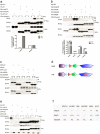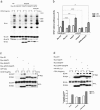Molecular mechanisms underlying the evolution of the slp76 signalosome
- PMID: 28473706
- PMCID: PMC5431462
- DOI: 10.1038/s41598-017-01660-0
Molecular mechanisms underlying the evolution of the slp76 signalosome
Abstract
The well-defined mammalian slp76-signalosome is crucial for T-cell immune response, yet whether slp76-signalosome exists in invertebrates and how it evolved remain unknown. Here we investigated slp76-signalosome from an evolutionary perspective in amphioxus Branchiostoma belcheri (bb). We proved slp76-signalosome components bbslp76, bbGADS and bbItk are present in amphioxus and bbslp76 interacts with bbGADS and bbItk, but differences exist between the interaction manners within slp76-signalosome components of amphioxus and human (h). Specifically, bbslp76 has a unique WW-domain that blocked its association with hItk and decreased TCR-induced tyrosine-phosphorylation and NFAT-activation. Deletion of WW-domain shifted the constitutive association between bbslp76 and hPLCγ1 to a TCR-enhanced association. Among slp76-signalosome, the interaction between slp76 and PLCγ1 is the most conserved and the binding between Itk and slp76 evolved from constitutive to stimulation-regulated. Sequence alignment and 3D structural analysis of slp76-signalosome molecules from keystone species indicated slp76 evolved into a more unfolded and flexible adaptor due to lack of WW-domain and several low-complexity-regions (LCRs) while GADS turned into a larger protein by a LCR gain, thus preparing more space for nucleating the coevolving slp76-signalosome. Altogether, through deletion of WW-domain and manipulation of LCRs, slp76-signalosome evolves from a rigid and stimulation-insensitive to a more flexible and stimulation-responding complex.
Conflict of interest statement
The authors declare that they have no competing interests.
Figures








Similar articles
-
Competition between SLP76 and LAT for PLCγ1 binding in resting T cells.Eur J Immunol. 2010 Aug;40(8):2330-9. doi: 10.1002/eji.200939411. Eur J Immunol. 2010. PMID: 20544725
-
The 14-3-3/SLP76 protein-protein interaction in T-cell receptor signalling: a structural and biophysical characterization.FEBS Lett. 2021 Feb;595(3):404-414. doi: 10.1002/1873-3468.13993. Epub 2020 Nov 22. FEBS Lett. 2021. PMID: 33159816
-
Inherited SLP76 deficiency in humans causes severe combined immunodeficiency, neutrophil and platelet defects.J Exp Med. 2021 Mar 1;218(3):e20201062. doi: 10.1084/jem.20201062. J Exp Med. 2021. PMID: 33231617 Free PMC article.
-
SLP76 and SLP65: complex regulation of signalling in lymphocytes and beyond.Nat Rev Immunol. 2006 Jan;6(1):67-78. doi: 10.1038/nri1750. Nat Rev Immunol. 2006. PMID: 16493428 Review.
-
Role of the LAT adaptor in T-cell development and Th2 differentiation.Adv Immunol. 2005;87:1-25. doi: 10.1016/S0065-2776(05)87001-4. Adv Immunol. 2005. PMID: 16102570 Review.
Cited by
-
Recent Advances in Molecular Mechanisms of the NKG2D Pathway in Hepatocellular Carcinoma.Biomolecules. 2020 Feb 14;10(2):301. doi: 10.3390/biom10020301. Biomolecules. 2020. PMID: 32075046 Free PMC article. Review.
-
Effect of MHC Linked 7-Gene Signature on Delayed Hepatocellular Carcinoma Recurrence.J Pers Med. 2021 Nov 2;11(11):1129. doi: 10.3390/jpm11111129. J Pers Med. 2021. PMID: 34834481 Free PMC article.
References
Publication types
MeSH terms
Substances
LinkOut - more resources
Full Text Sources
Other Literature Sources

